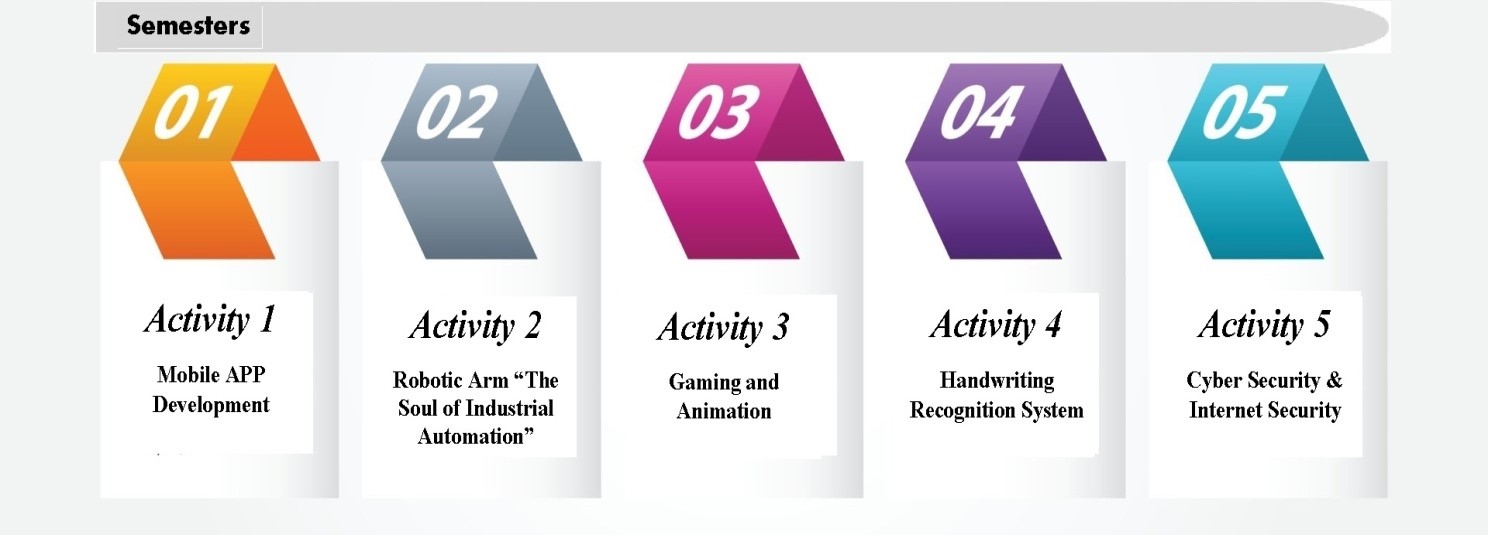Computer science experiential learning is a dynamic approach that empowers students to apply theoretical knowledge to real-world scenarios, fostering a deeper understanding of core concepts and cultivating essential skills for success in the field. Through hands-on activities such as project-based learning, students engage in problem-solving, collaboration, and critical thinking. These experiences not only deepen technical proficiency but also cultivate creativity, adaptability, and effective communication. By immersing themselves in authentic tasks and challenges, students gain practical insights into software development, data analysis, cybersecurity, artificial intelligence, and other key areas of computer science. Experiential learning not only equips students with the skills needed to thrive in today's rapidly evolving technological landscape but also instills a lifelong passion for innovation and discovery.

|
Table 1: ELC Activities Details |
||||
|
Semester 1: Mobile APP Development |
||||
|
|
A mobile app development experiential learning activity is a hands-on project in which students create a mobile application. This activity provides students with hands-on experience in creating a mobile app, including design, development, and testing. It also gives them an understanding of the complete app development process and the challenges in creating a successful mobile app.
Faculty Facilitator Dr. Simran Setia (Team Lead) Dr. Vaibhav Aggarwal Dr. Tanya Garg Dr. Gourav Jain Dr. Rahul Nijhawan |
|
The basic outline of the activity is:
|
|
|
|
Semester 2: Robotic Arm “The Soul of Industrial Automation” |
||||
|
|
A robotic arm, controlled by using Arduino programming, is an experiential learning activity in industrial automation and robotics. Arduino is an open-source electronics platform that allows students to control the robotic arm through simple and accessible coding easily. This activity provides students with hands-on experience in programming and building a robotic arm with an understanding of industrial automation and robotics technology.
Faculty Facilitator Dr. Sachin Kansal (Team Lead) Dr. Rohan Sharma Dr. Vivek Sethi Dr. Mandeep Kaur |
|
The basic outline of the activity is:
|
|
|
|
Semester 3: Gaming and Animation |
||||
|
|
A gaming and animation experiential learning activity is a hands-on project in which students create a game or an animated project. Such activities provide the opportunity for students to gain experience in areas such as game design animation techniques, and programming. Such hands-on activities help students understand the challenges of creating successful interactive projects. Faculty Facilitators Dr. Shailendra Tiwari (Team Lead) |
|
The basic outline of the activity is:
|
|
|
|
Semester 4: Handwriting Recognition System |
||||
|
|
A handwriting recognition system experiential learning activity is a hands-on project in which students create a system that can recognize handwritten text and generate a summary of the recognized text. This activity allows students to gain experience in computer vision, natural language processing (NLP), and machine learning.
Faculty Facilitator Dr. Ravinder Kumar (Team Lead) Dr. Ashima Anand Dr. Sanjeev Rao Dr. Aditi Sharma |
|
The basic outline of the activity is:
|
|
|
|
Semester 5: Cyber Security & Internet Security |
||||
|
|
A Cyber Security and Internet Security experiential learning activity using IoT sensors like alarms, cameras, RFID, proximity sensors, and LCD-display is a hands-on project in which students learn and experience the various challenges in protecting computer systems and networks. It gives them an understanding of the security challenges that arise in the context of IoT and the importance of secure communication and data storage in IoT networks.
Faculty Facilitator
Dr. TarunpreetBhatia (Team Lead) Dr. Rohit Ahuja Dr. Vaibhav Pandey Dr. Ranjeet Ranjan Dr. Shubra Dwivedi |
|
The basic outline of the activity is:
|
|
|